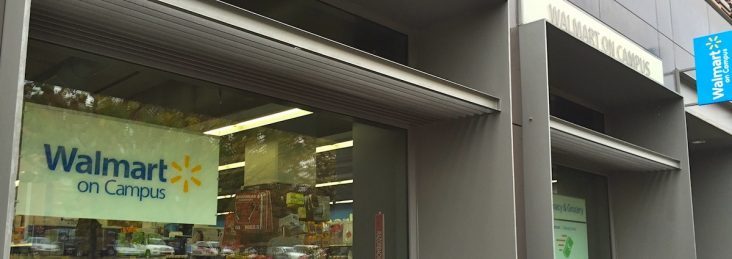Future uncertain for Walmart campus store experiment, two of five stores have closed
by October 13, 2016 6:43 pm 1,983 views

The Walmart Express Campus store experiment was unveiled in 2011 with the opening of a mini-convenience store at the University of Arkansas in Fayetteville. But the retailer has closed two of the five stores in the pilot program in the past year leaving many to wonder if the concept will soon end.
The Walmart Express campus store at the University of Missouri was closed Oct. 7, after the retailer opted to not renew a lease agreement. Last summer Walmart U.S. closed its campus store on the Georgia Tech campus about two years after it opened. The company did not give a reason for the Georgia store closing. In the spring of 2015, Walmart opened a campus store at Virginia Commonwealth University, just three months before it closed the store at Georgia Tech.
Walmart U.S. has just three – University of Arkansas, Arizona State University (Tempe, Ariz.) and the Richmond campus at Virginia Commonwealth, according to Walmart corporate spokeswoman Delia Garcia – of the campus stores in operation, which is not enough sampling for the retailer to assess the format, according to some retail consultants.
When the mini-store concept began, then Walmart U.S. CEO Bill Simon had a mission to explore the small-store convenience model formats as supercenter traffic was being hammered by the smaller dollar store chains. But when Greg Foran was named Walmart U.S. CEO, much of the retail giant’s focus has been to turn around supercenter business which Foran has said is the company’s best profit center.
Walmart U.S. will open fewer brick and mortar stores being next year. Wal-Mart Stores execs have said U.S. capital expenditures next year will be $11 billion, with twice as much going to e-commerce and tech investments than to new stores. The retailer is also investing more in store remodels to match new store concepts that seek to do better with fresh foods and include online grocery pick-up areas. The online grocery option will be rolled to 500 locations by the end of next year.
Thomas Jensen, marketing professor in retail at the University of Arkansas, said part of the reason Walmart and other retailers moved to college campuses was to try and gain insight into the younger generation and establish brand loyalty at the earliest stage of their young adult lives.
“Retailers have a captive market when they are on college campuses and they lease space which is a lower cost than building out their own formats. I understand the college campus stores are a pilot test to learn about really small store mechanics in addition to be a branding effort,” Jensen said.
He said the pharmacy component of the campus stores were a huge draw when store the first opened, at least in at the University of Arkansas. He said state laws prohibited the university’s pharmacy from distributing or filling prescriptions for contraceptives. He said Walmart took advantage of this and devoted a large amount of store space to selling contraceptive products in the local pharmacy.
Jensen also said this was a convenience for students who didn’t have to leave campus for medications and contraceptives. He said merchandising the tiny format (4,600 square feet) was likely challenging for the retailer accustomed to stocking 46,000 items in a neighborhood market format or 100,000 items in a supercenter. The mini campus format does not stock fresh foods but does carry some frozen food items.
“It seemed odd to me that I could buy just about everything I needed to make tacos in the campus store but no meat. It dawned on me that this format would only work for those students on campus who don’t have to prepare their own meals. It would be difficult for a student in a neighboring apartment responsible for their own meals to find everything they would need at the campus store,” Jensen said.
Replenishment of small urban-like stores also takes some wrangling, Jensen said.
“There’s no way Walmart can park a semi and unload into the Fayetteville campus store. Walmart uses a van from a neighboring supercenter to replenish the store inventory,” he added.
He said as Walmart’s business is changing and more transactions move online, it makes sense for Walmart to invest in its bigger stores and turn them into pick-up and fulfillment centers for the online shoppers. Jensen said the tiny stores likely don’t generate enough profit to stand on their own given the limited number of items and remote shopping pool.
That said, Jensen said in the beginning he thought Walmart was using the tiny formats to gain insight into how to run really small formats in urban areas like New York City or Boston. However, Foran continues to be bullish on the supercenter format and recently said Walmart would focus on opening bigger stores in outlying areas rather than going into more expensive, densely populated urban centers like Manhattan.
Jensen said there are undoubtedly learnings that Walmart can take from this campus store experiment even if it does wind down the pilot in the next year.
